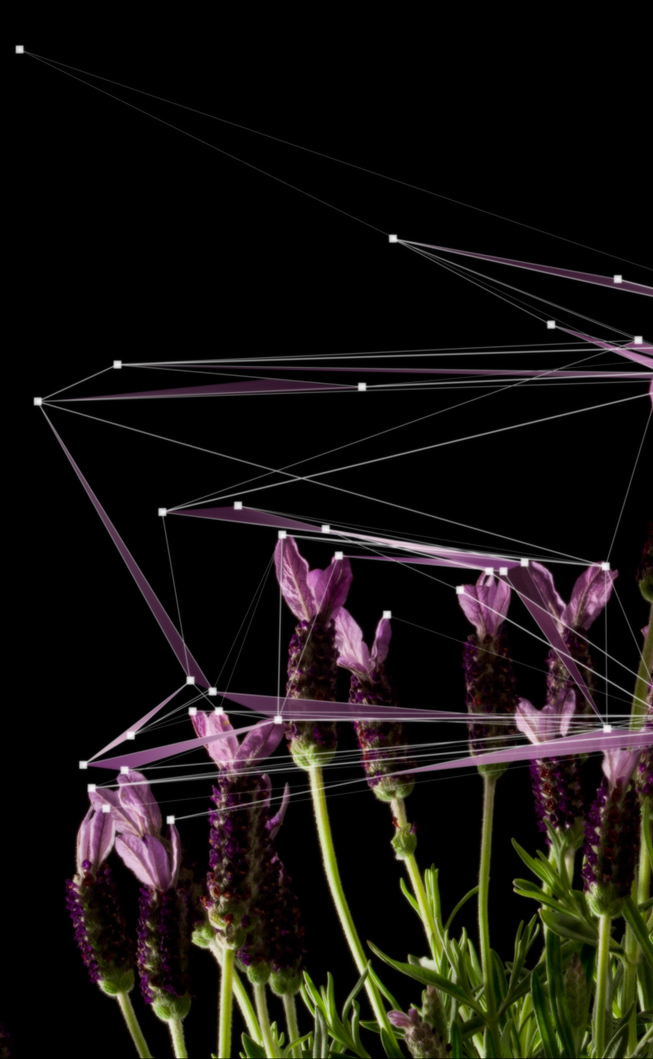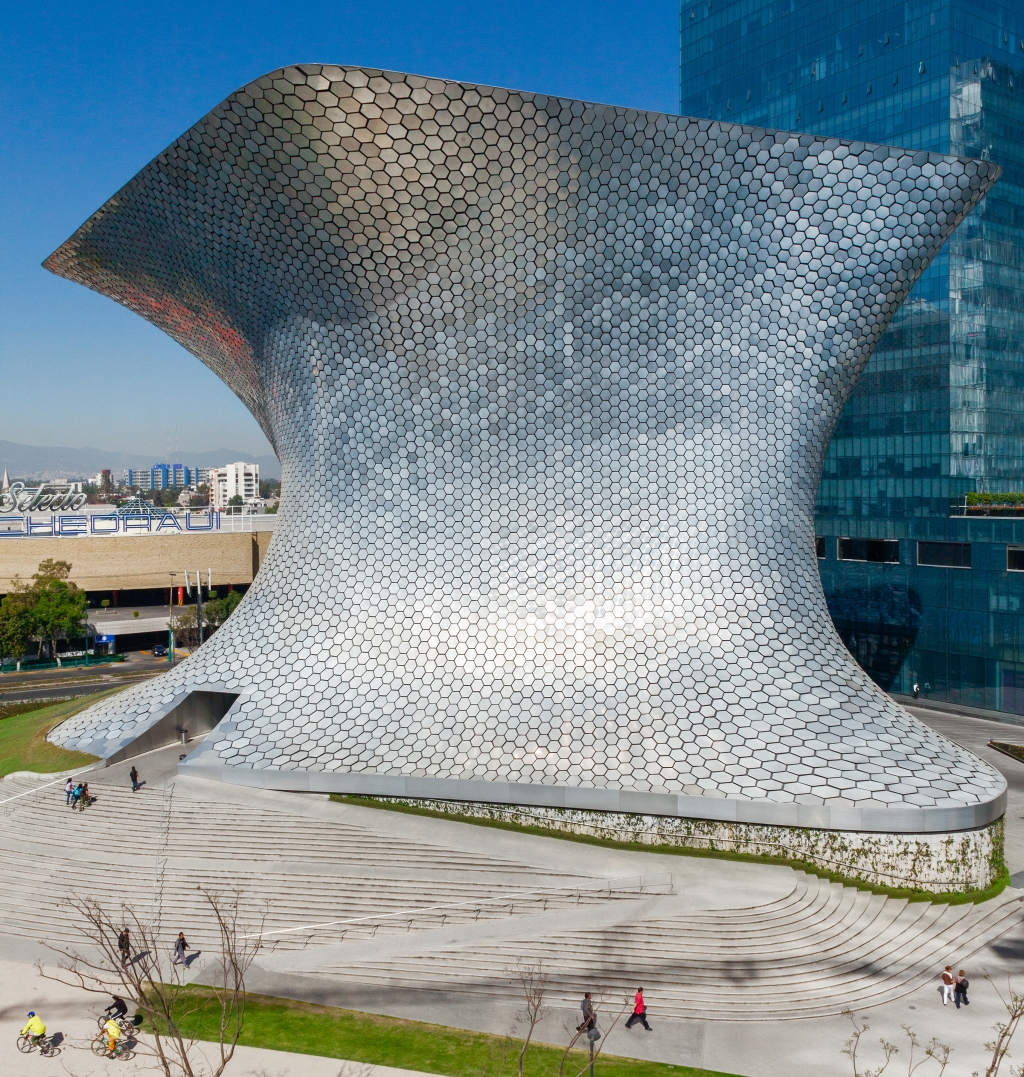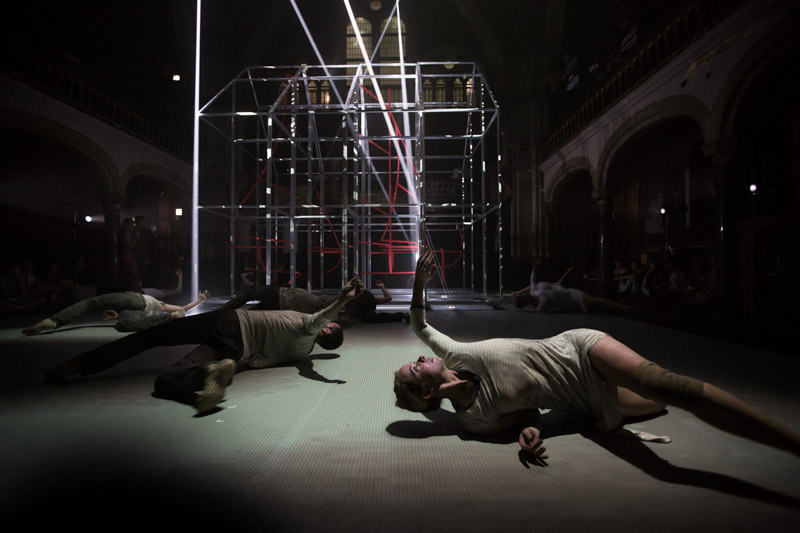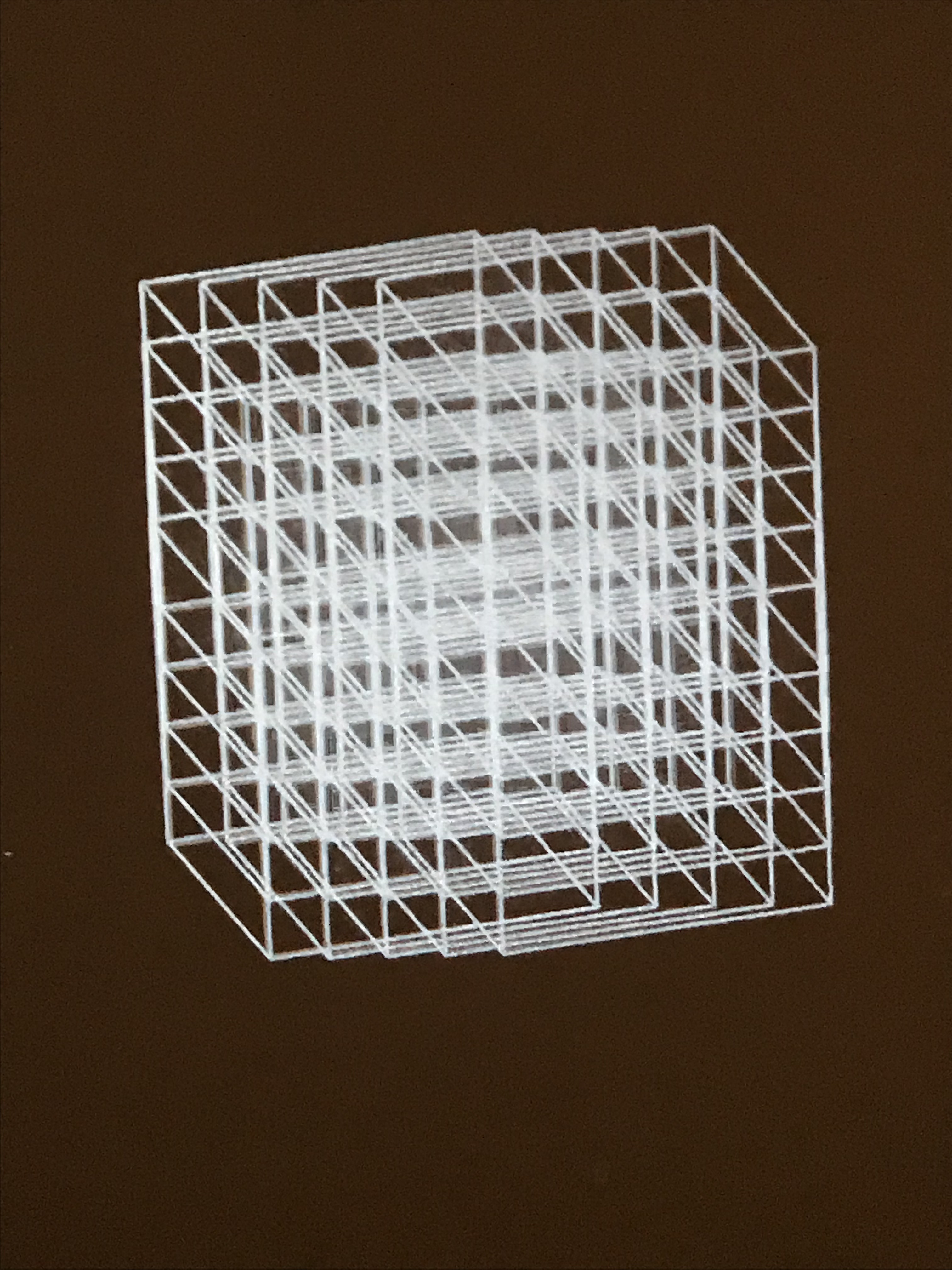
QUAYOLA
Natures
“…explore the dialogue between the natural and the artificial”, connecting footage of plants moving in the wind with line structures tracked on top”. Mate Steinforth

Natures
“…explore the dialogue between the natural and the artificial”, connecting footage of plants moving in the wind with line structures tracked on top”. Mate Steinforth

فرناندو روميرو
费尔南多·罗梅罗
フェルナンド·ロメロ
페르난도 로메로
Soumaya Museum
Museum buildings tend to be conceived either for maximum functionality – acting as neutral containers for art – or as iconic structures that represent a city at a particular historic moment. The Museo Soumaya was designed as both: a sculptural building that is unique and contemporary, yet one able to house a collection of international paintings, sculptures, and decorative objects dating from the fourteenth century to the present.The exterior of the building is an amorphous shape perceived differently from every angle, reflecting the diversity of the collection inside. The building’s distinctive façade is made of hexagonal aluminum modules facilitating its preservation and durability. The shell is constructed with steel columns of different diameters, each with its own geometry and shape, creating non-linear circulation paths for the visitor. The building encompasses 20,000 square meters of exhibition space divided among five floors, as well as an auditorium, café, offices, gift shop, and multipurpose lobby. The top floor is the largest space in the museum, with its roof suspended from a cantilever that allows in natural daylight.

“6 Sided Plane in 5 Masses and 3 Scales with 2 Free Regions
The drawings also clarify the schema underlying the locations of the bored holes in the sculptures. Situated along lines linking vertices at the perimeter of the forms, they recall constellation maps or, as with 8 Sided Plane in 7 Masses and 2 Scales with Free Region (1975/2018), the plans of Romanesque cathedrals. Here, again, the relationship is inverted. The black shapes representing the solid stone columns in the plans echo the shafts of air bored through the steel. The term “Romanesque” appears frequently in Rabinowitch’s titles. Though absent here, the conglomeration of shapes visible in Romanesque church plans, like those of Cluny in France, bear an affinity with the additive sensibility evident in Rabinowitch’s structures. Donald Kuspit has focused attention on the artist’s interest in Northwest Coast traditions, especially the totem pole. Like the totem pole, Rabinowitch’s works manifest a “disrupted continuum,” a whole built out of distinct parts. For me, the presence of the drawings in this exhibition subtly undermined that assertion. The lines along which the bored holes are situated form a network that passes over all (or at least most) of the components in each work, in effect linking them. Though no longer visible in the steel versions, the connective links act as a reminder of this second related principle of organization. Some may see it as a complication, a discrepancy, or be disappointed by the realization, but I think it helps demystify these “new” early sculptures. At the same time, the proximity of the studies by no means diminished the deep-rooted and intriguing complexity of Rabinowitch’s sculptural work.”John Gayer

Thixotropes
They’re called Thixotropes. Compositions comprised of eight illuminated mechanized structures create choreographies of lighting effects that alternate form warm to cold light. Designed by London based design firm Troika, these suspended systems merge technology with art and explore the realm in which rational observations intersect with the metaphysical and surreal. Each of the structures is shaped as a composition of intersecting angular and geometric forms, made of thin tensed banding lined with rows of LED’s. The constructions continuously revolve around their own axis thereby materializing the path of the light and dissolving the spinning structures into compositions of aerial cones, spheres and ribbons of warm and cold light while giving life and shape to an immaterial construct.

NEST
Inspired by Homer’s Odyssey
Loosely based on Homer’s The Odyssey, Marshmallow Laser Feast’s light installation lit the primary performance space within the chapel’s hazy internal dome. Grid-like projections crossed with mobile structures (designed by the architectural practice Studio Weave) as agile bodies crept over, in and through the many lit towers and surfaces. This first act was seen by the audience from the left and right balconies above. The second act, down flights of rope-lined staircases in the concrete basement, was more disorienting, lit only with triangular neon tubing and an eerie glow that seeped from an open door. The style of dance, in keeping with the more rapid and percussive score, by Canadian composer Christopher Mayo and electronic music composer / performer Anna Meredith, confronted the audience and was staged without boundaries dividing the dancers (some of whom were in street clothes) and viewers.

Abysmal
Abysmal means bottomless; resembling an abyss in depth; unfathomable. Perception is a procedure of acquiring, interpreting, selecting, and organizing sensory information. Perception presumes sensing. In people, perception is aided by sensory organs. In the area of AI, perception mechanism puts the data acquired by the sensors together in a meaningful manner. Machine perception is the capability of a computer system to interpret data in a manner that is similar to the way humans use their senses to relate to the world around them. Inspired by the brain, deep neural networks (DNN) are thought to learn abstract representations through their hierarchical architecture. The work mostly shows the ‘hidden’ transformations happening in a network: summing and multiplying things, adding some non-linearities, creating common basic structures, patterns inside data. It creates highly non-linear functions that map ‘un-knowledge’ to ‘knowledge’.

ЭСТЕР СТОКЕР
에스더 스토커
以斯帖施特克尔
In addition to painting on the usual canvas, Esther Stocker creates her minimal abstract work on entire rooms and structures. The Italian artist has been creating her black and white installations and wall works since 2001, which have been exhibited all over the world. Esther uses stark geometric lines to create a shaken sense of depth perception and spatial uncertainty in the eyes of the viewer, to which she simply explains: “Control is always what we do not have. This is the human condition.”

The Self-Assembly Line
Can we create objects that assemble themselves — that zip together like a strand of DNA or that have the ability for transformation embedded into them? These are the questions that Skylar Tibbits investigates in his Self-Assembly Lab at MIT, a cross-disciplinary research space where designers, scientists and engineers come together to find ways for disordered parts to become ordered structures.

Cubic Limit
In «Cubic Limit,» Mohr introduces the cube into his work as a fixed system with which signs are generated. In the first part of this work phase (1972–75), an alphabet of signs is created from the twelve lines of a cube. In some works, statistics and rotation are used in the algorithm to generate signs. In others, combinatorial, logical and additive operators generate the global and local structures of the images.

КАЙЛ ДАНН
A Bunch of Heavy Lines
The liveliness of buildings and stationary structures at the Headlands is a major draw and source of influence for my work. I have noticed that architectural elements of my studio in the basement of building 960 formed an interesting dialogue with my pursued work.

СЕРИС ВИН ЭВАНС
ケリス·ウィン·エヴァンス
Form in Space…By Light
‘Cerith’s installation sits beautifully within the space, unfolding as you walk through,’ explains Clarrie Wallis, Tate’s Senior Curator of Contemporary British Art. The neon experience builds, from a single ‘peep hole’ ring in the South Duveens, through which you can glimpse swirls of radial light and an imposing octagon in the central gallery. The fractured neon fragments look like frantically drawn sparkler-lines on fireworks night.But there’s method and logic within these celestial scribbles. Hidden in the design are references to a host of highbrow sources, from Japanese ‘Noh’ theatre, to Marcel Duchamp’s The Bride Stripped Bare by her Bachelors, Even (The Large Glass), 1915-23. Don’t worry if you missed them. The beauty of rendering precise (verging on obscure) references in such a celebratory neon explosion allows for multiple – if not endless – interpretations.Each way you look at the sprawling 2km of neon tubing, a different shape or symbol emerges. No small thanks to the elegant way in which the structures have been painstakingly suspended. ‘There were over 1000 fixing points, and obviously we couldn’t drill 1000 holes in the Grade II listed building,’ Wallis explains. ‘We had to work with structural engineers very intensely, so as to be completely happy and convinced that we would be able to remove it without damaging the fabric of the building.’Though it seems too soon to be discussing the installation’s removal, Wallis has a point. It’s a visibly fragile, delicate sculpture – whose impermanence makes it more intriguing. As it is a site-specific sculpture, it can’t be recreated elsewhere. What’s more, because the neon tubes are filled with a constantly moving stream of pulsing, vibrating gasses, visitors will never see the same sculpture twice.

Field and Loops
Loops and Fields, is a collection of drawings that resonate sympathetically to the electromagnetic fields within the gallery. These graphite drawings function as graphic antennas and explore the qualities and inherent nature of a combination of hand-drawn and mathematically generated forms. Delving into algorithmic structures, fractals and the chaotic nature of the hand drawn line, these drawings are an exploration of conductive materials and the possibilities for drawing electronic components. When connected to a sound system they make audible their interior activity and reveal the energy that exists in the immediate environment.Relying on the basic principles of the directional loop antenna, the drawings in Loops and Fields, like any receiving antenna, convert an electromagnetic wave into a voltage; the loop antenna is particularly sensitive to magnetic fields and outputs a voltage proportional to that field. Monitoring this activity allows us to experience the local fields and generates a site-specific and dynamic aural landscape.The different shapes and line qualities that make up the algorithmically generated and stencilled drawings come from thinking about the possibilities of extending a line. Fractal mathematics and the research into fractal antennas has focused on reducing the overall size and space an antenna needs to occupy. My interest is in the frequency range at the lower regions of the spectrum, where the wavelength is large; so my interpretation of recent antenna design research has led me to explore the possibilities for drawing antennas that can receive large wavelengths, on something the size of a standard piece of fine art paper.

lumiére
a complete new version, the result of performing Lumière for more than one year, condensed into a more sophisticated, more complex, more fragile, more massive synaesthetic experience! photos and more info online in early February.Based on self written software, this work on the edge of concert and site specific installation finds previously unseen beauty and minimalistic elegance in a commonly underrated medium. High power lasers draw complex morphing shapes and connect points in space. Lumière combines precise geometric figures with floating organic structures, presenting the archaic sign language of an alien culture communicating via emerging and disappearing traces of extremely bright light.Percussive and textural sonic events provide a counterpoint to the visual rhythm, resulting in a multi sensorial experience which at times is fragile and quiet, at others massive and overwhelming. Each Lumière performance is a unique and site specific real time exploration of synchronicity and divergence, of light and darkness at the limits of perception.

设计工作室新兴对象
Saltygloo
American studio Emerging Objects 3D-printed this pavilion using salt harvested from San Francisco Bay. “The structure is an experiment in 3D printing using locally harvested salt from the San Francisco Bay to produce a large-scale, lightweight, additive manufactured structures,” said Ronald Rael and Virginia San Fratello of additive manufacturing startup Emerging Objects. They explained that 500,000 tonnes of sea salt are harvested each year in the San Francisco Bay Area using power from the sun and wind. “The salt is harvested from 109-year-old salt crystallisation ponds in Redwood City,” they said. “These ponds are the final stop in a five-year salt-making process that involves moving bay water through a series of evaporation ponds. In these ponds the highly saline water completes evaporation, leaving 8-12 inches of solid crystallised salt that is then harvested for industrial use.”

Джон Мак-Кракен
约翰·麦克拉肯
ジョン·マクラッケン
Star, Infinite, Dimension, and Electron
“The geometric forms McCracken employed were typically built from straight lines: cubes, rectangular slabs and rods, stepped or quadrilateral pyramids, post-and-lintel structures and, most memorably, tall planks that lean against the wall. Usually, the form is painted in sprayed lacquer, which does not reveal the artist’s hand. An industrial look is belied by sensuous color.His palette included bubble-gum pink, lemon yellow, deep sapphire and ebony, usually applied as a monochrome. Sometimes an application of multiple colors marbleizes or runs down the sculpture’s surface, like a molten lava flow. He also made objects of softly stained wood or, in recent years, highly polished bronze and reflective stainless steel.Embracing formal impurity at a time when purity was highly prized, the works embody perceptual and philosophical conundrums. The colored planks stand on the floor like sculptures; rely on the wall for support like paintings; and, bridging both floor and wall, define architectural space. Their shape is resolutely linear, but the point at which the line assumes the dimensional properties of a shape is indefinable.” Christopher Knight